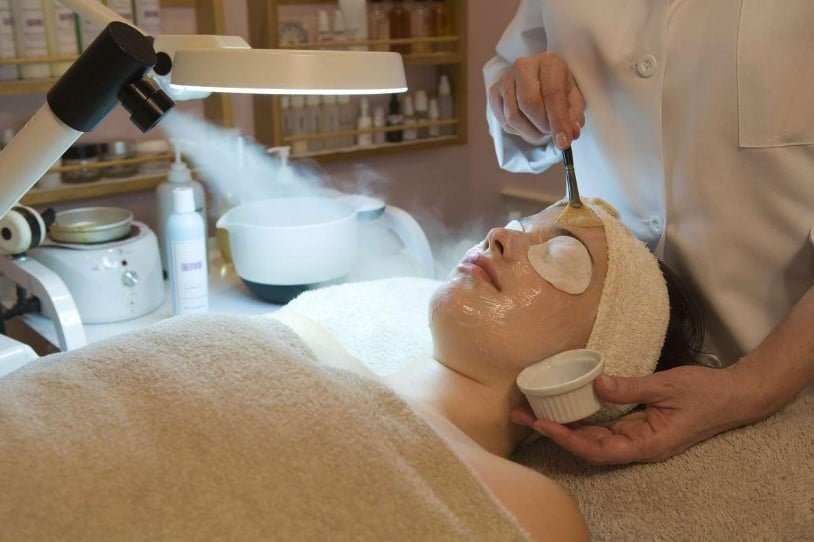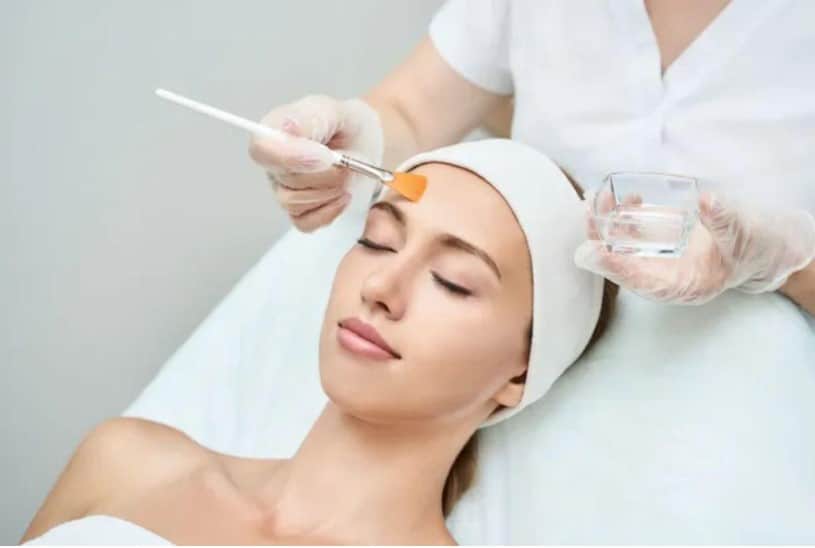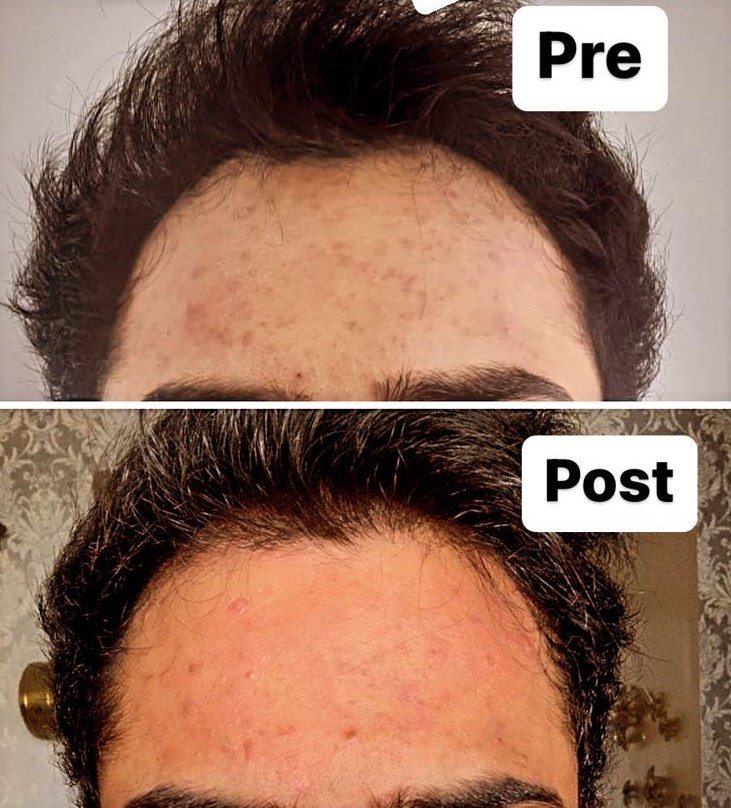Acne/Chemical Peel Treatment In Indiranagar, Bangalore
What is an Acne peel?
Aestheticaabymadhulika offers a variety of peels that can help treat acne and improve skin texture. The most popular acne peels for treatment include glycolic acid, salicylic acid, and high-frequency peels. Each of these has its benefits and is tailored to different skin types. A chemical solution is applied to the skin during an acne peel, a cosmetic procedure that aims to exfoliate the skin’s surface and treat acne, acne scars, and other skin flaws.

Benefits of Acne peel
- Brightens skin
- stimulates collagen production
- improves skin texture.
- Deep exfoliation: Removes dead skin cells.
- Reduces acne scars: Improves skin texture.
- Even skin tone: Fades hyperpigmentation.
- Controls oil production: Reduces sebum buildup.
- Reduces inflammation: Calms active acne.
- Boosts collagen: Promotes skin firmness.
- Unclogs pores: Minimizes blackheads, whiteheads.
- Prevents breakouts: Keeps pores clear.
- Customizable treatment: Tailored to skin needs.
- Enhances skincare absorption: Improves product effectiveness.
- Anti-aging effects: Reduces fine lines.
- Minimizes downtime: Quick recovery period.

CHECK-LIST FOR CHEMICAL PEELING PREPARATION :
- Make sure you are aware of the “Dos and Don’ts” about the advanced peel treatment. If there is a preparatory checklist available, ask your doctor for it.
- For the following candidates, the therapy is not advised:
- Individuals whose post-inflammatory hyperpigmentation history is known
- Individuals who are prone to cold sores or who recently had an outbreak
- ladies who are expecting or nursing
Acne can be treated with various chemical peels, each with its advantages. We offer the best chemical peel service, which is given below:
- Glycolic acid peels
- high-frequency peels
- Superficial Peel
- Peels for Advanced Lightening
These are the most popular peels used to treat acne.
Glycolic acid peels
Glycolic acid peels help unclog pores and reduce sebum buildup, leading to acne breakouts. Peels containing glycolic acid also encourage the synthesis of collagen, which can assist in lessening the visibility of acne scars.
high-frequency peels
The recent high-frequency peels use high-frequency sound waves to enter the skin and sincerely encourage healing. High-frequency peels can lessen the frequency and severity of issues associated with acne.
Superficial peels
Chemical or superficial peels are a cosmetic treatment that exfoliates the skin by removing dead skin cells and revealing smoother, more vibrant skin. This covers peels containing AHA and BHA.
Benefits of superficial peels:
- It enhances skin tone and texture and minimizes the appearance of wrinkles and fine lines
- helps to clear clogged pores and stop acne outbreaks
- gives a more youthful, luminous complexion
- Before treatment, get ready by discontinuing the usage of any facial cosmetics.
- Avoid tanning or excessive sun exposure.
Peels for Advanced Lightening
These chemical peels reduce the visibility of dark spots, hyperpigmentation, and other skin discoloration by using a combination of whitening agents. Anywhere on the body can be used for this.
Benefits
- minimizes hyperpigmentation
- It enhances Skin Texture and Reduces Wrinkles and Fine Lines
- the Radiance of the Skin Overall
- Prepare for Treatment and Prevent Sun Exposure
- Don’t Use Specific Skincare Products
Procedure

An Acne peel is a procedure for resurfacing the skin. The top layers are removed from the face, hands, and neck using a chemical peel as a cosmetic procedure. It is the process that contributes to enhancing the skin’s look. A chemical solution will be applied topically to the treated region during this treatment, making the skin exfoliate and eventually peel off. During the post-chemical procedure, the new skin that grows back appears suppler, less wrinkled, and prone to minimal damage.
Purpose
People use chemical peels for many different kinds of reasons. People typically choose this beauty treatment for the following issues:
- Fine lines and wrinkles
- sun fading
- acne scarring
- Hyperpigmentation
- Melasma
- Changing skin tone
- Redness

Who is eligible for a peeling treatment?
- Acne-prone skin: Ideal for treating acne and acne scars.
- Hyperpigmentation: Suitable for uneven skin tone or dark spots.
- Fine lines and wrinkles: Helps reduce early signs of aging.
- Oily, combination, or normal skin: Most compatible with peeling treatments.
- Mild to moderate acne scars: Improves skin texture over time.
- People seeking smoother skin: Great for exfoliation and rejuvenation.
- Consultation needed for sensitive skin: Should consult a dermatologist first.
- Avoid if pregnant or breastfeeding: Some peels may not be safe.
- Avoid during active infections or sunburn: Peeling can worsen skin irritation.
- Caution with retinoid users: Strong acne medications may require milder peels.
Peeling is beneficial in the following circumstances:
Peels may be used to traditional anti-acne treatments for acne (pimples). It enhances acne scars, accelerates acne healing, and improves pimple pigmentation markings.
When quicker results are needed for a social occasion like a marriage, they are quite beneficial. Additionally, they may be used as an adjuvant to local therapy in women who are pregnant or nursing.
Melasma (blemishes), tanning: Some individuals may have redness and other negative effects with the medications now on the market for blemishes, or the medications may not be able to completely treat the condition. Peeling is an excellent substitute for these people. It may also be used to the remaining patients with imperfections.
Antiaging and rejuvenation: Regular (once every two weeks or month) peels can minimise the appearance of fine lines, age spots, freckles, and the dry, rough texture of ageing skin. They should begin before the ageing indicators materialise for the optimum benefits, ideally by the time a person reaches the age of 23 or 25.
Party peels: for a quick and radiant complexion
Dark circles under the eyes: a safe, practical, and wise choice since powerful medications shouldn’t be applied near the eyes.
Body peels: In addition to the face, peels treatment in bangalore may be used to treat skin conditions like Acanthosis Nigricans , Keratosis Pilaris ,back acne , dark spots on the neck, dark underarms, knees, elbows, arms , legs etc.
At Aestheticaa by Dr Madhulika, we effectively perform around forty peels every month for a range of reasons. The process just takes fifteen minutes. The patient is encouraged to use sunscreen and sun protection. Following the operation, the patient also receives a post-peel instruction document for their records.
What are the Risks involved?
Possible complications of chemical peels
Certain skin types run the danger of either permanently or temporarily changing your skin’s colour. Using birth control pills, pregnancy, or a family history of brownish discolouration on your face might raise your chance of abnormal pigment development.
Certain parts of your face may also show minimal risk of scarring; other people may be more prone to scarring in other locations. Should scarring develop, it is often treatable with high success.
Should you have a history of herpes outbreaks, there is a little risk of reopening the cold sore. Your dermatologist may write prescriptions for drugs meant to lower the likelihood of a flare-up. As advised by your doctor, follow her directions.
Tell your dermatologist if you have a history of keloids—scar tissue expansion resulting from a skin damage—any atypical scarring tendencies, any X-rays of your face or cold sores before your chemical peel.
Though infrequent, infections nonetheless pose a danger.
Before and After Precautions for Chemical Peel Treatment
The following are some pre- and post- chemical peel in bangalore safety measures to take into account:
Before doing a chemical peel
- AHA, BHA, PHA, and retinol-based products should not be used at least 7–10 days before to the treatment.
- Try not to use tanning beds for at least two weeks before the procedure.
- Keep out of the sun for a long period 10 days before the procedure.
- Wait seven days before waxing your face.
- It is best to talk about stopping acne treatment creams or acne scar treatment in indiranagar with your skin specialist.
- Don’t forget to use broad-spectrum sunscreen on the day of the facial peeling procedure.
Do not work out the day before the therapy. - Avoid using any anti-inflammatory medications seven to ten days before to the skin peel procedure.
- After receiving a chemical peel, wash your skin with a mild cleanser.
- Apply topical antibiotic cream to wounds and prevent infections.
- Make sure to use a broad-spectrum sunscreen on a daily basis.
What happens during the procedure at Aestheticaa?
An acne-buster work in many different ways. It can be done using dynamic pulse light, an acne mask, a face peel, or another type of peel. The process’s goal is to resolve acne issues on the skin. Our specialists have used the acne-buster method for a very long time. They all are involved in employing the latest innovations during the procedure.

Acne Buster Peel
Acne, acne scars, and blocked pores can all be treated using the Acne Buster method. Acne buster can effectively treat all of these skin issues. You can receive this type of care.
Conditions that Acne Buster treats: This treatment is suitable for:
- How to treat acne
- greasy face
- issues with pores

Is Acne peel good for the skin?
Absolutely! They function by exfoliating the skin to eliminate pollutants and dead skin cells that might result in breakouts. High-frequency peels, salicylic acid peels, and glycolic acid peels are all employed to lessen the visibility of acne scars and enhance the general texture and tone of the skin. Acne peels also aid in reducing hyperpigmentation brought on by pimples or other blemish-related conditions. In conclusion, chemical peels can be a valuable technique for enhancing the brightness and softness of your skin.
What should I expect after the chemical peel?
Depending on the degree of your chemical peel, there are different expectations:
After receiving a best chemical peel treatment bangalore you should anticipate experiencing a response similar to a sunburn: redness followed by scaling that lasts for three to seven days.
As prescribed, use cream or lotion to your skin until it heals. Apply sunscreen every day once your skin has healed.
After treatment, you may apply makeup right away or the next day.
Every two to five weeks, you may have more peels until you get the results you want. To reach your objective, usually take three to five peels.
If your chemical peel was a medium one:
You may have some skin peeling, stinging, redness, and swelling. For 48 hours, swelling can persist and/or become worse. Blisters have the potential to form and rupture. After seven to fourteen days, the skin will peel off and crust.
As prescribed by your physician, carry out daily soaks. Use ointment after each soak. Use cream or lotion every day. Wait until your skin has healed fully before exposing it to the sun.
It will take ten to fourteen days to finish taking antiviral medicine.
It is possible to apply makeup five to seven days later.
If necessary, more medium-depth peels may be performed six to eight weeks interval
Contact your doctor if your skin becomes itchy, swollen, or burns. An infection might result from skin scratches.
Your expectations for the procedure
You can trust our expertise since we have faith in our medicinal properties. Your skin will become clear and acne-free. There is no downtime related to this procedure, unlike other skin treatments. So soon after the therapy, you may walk home again. You’ll look better after having an acne-buster done at Aestheticaa .

